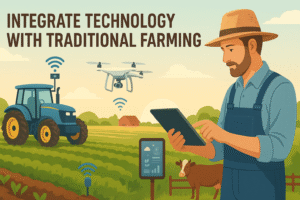Integrate Technology with Traditional Farming
As agriculture faces mounting pressures from climate change,how to integrate technology with traditional farming labor shortages, and rising demand for food, integrating technology with traditional farming methods is no longer optional—it’s essential.Integrate Technology with Traditional Farming

In this guide, we’ll explore how to integrate technology with traditional farming, with a focus on practical steps, innovative tools, and real-world benefits for farmers in the UK and USA.
Whether you’re a small-scale grower or a large-scale producer, you’ll find actionable insights to enhance productivity while preserving time-honored agricultural practices.
Table of Contents
Why Integrate Technology with Traditional Farming?
Meeting Modern Demands
With growing consumer demand for sustainable, traceable, and high-quality food, farmers must embrace smart technologies to stay competitive.
Benefits of Tech Integration
-
Increased crop yields with precision agriculture
-
Efficient resource management (water, fertilizer, energy)
-
Reduced environmental impact
-
Better livestock monitoring
-
Automated data collection and analysis
Traditional farming practices are rich in cultural and environmental wisdom. Merging this with modern innovation creates a robust, sustainable farming model.Integrate Technology with Traditional Farming
Top Technologies Transforming Agriculture
Here’s a look at key agricultural technologies being used across the UK and USA:
1. Precision Agriculture
Definition: Use of GPS, IoT, and data analytics to manage crops and soil with precision.
-
GPS-guided tractors
-
Drone-based soil mapping
-
Variable rate technology (VRT)
Benefits:
-
Minimizes waste
-
Increases productivity
-
Improves soil health
2. Drones and Aerial Imaging
Used for:
-
Crop health monitoring
-
Pest detection
-
Irrigation planning
3. IoT Sensors
Installed in:
-
Soil
-
Irrigation systems
-
Animal enclosures
Function: Real-time monitoring of moisture, pH, temperature, livestock health.
4. Farm Management Software
Helps farmers:
-
Plan crops
-
Track expenses
-
Monitor equipment
-
Generate compliance reports
5. Automated Machinery
Includes:
-
Robotic milkers
-
Self-driving tractors
-
Automated harvesters
6. Blockchain in Agriculture
Used for:
-
Food traceability
-
Reducing supply chain fraud
-
Smart contracts with suppliers
Step-by-Step Guide to Integration
Successfully integrating technology into traditional farming requires planning and adaptation. Here’s a simplified path to get started:
Step 1: Assess Your Farm’s Current Setup
-
Evaluate farm size and type (dairy, arable, mixed)
-
Identify key pain points (e.g., labor, yield, costs)
-
Set clear goals (increase yield, reduce input, boost sustainability)
Step 2: Choose the Right Technology
Match tech solutions to specific needs:
-
Want better water use? → Install soil moisture sensors
-
Trouble tracking cattle health? → Try wearable livestock trackers
-
Labor shortage? → Invest in robotic weeders or pickers
Step 3: Start Small
Begin with a pilot area or one process:
-
Automate irrigation before scaling to crop monitoring
-
Use drone imagery on one field before expanding
Step 4: Train Yourself and Your Staff
-
Attend local agri-tech workshops
-
Partner with AgTech companies for training
-
Use online platforms and demos
Step 5: Monitor and Adjust
-
Analyze data collected by sensors and drones
-
Fine-tune your approach season by season
-
Integrate feedback from workers and customers
Challenges and How to Overcome Them
Despite the benefits, farmers may face hurdles. Here’s how to navigate them:
| Challenge | Solution |
|---|---|
| High Initial Costs | Apply for government grants and agri-tech subsidies (e.g., DEFRA in the UK, USDA in the USA) |
| Digital Skills Gap | Collaborate with local agri-tech advisors or universities |
| Resistance to Change | Start small to build confidence and show tangible benefits |
| Connectivity Issues in Rural Areas | Use low-bandwidth IoT tools or mesh networks |
Case Studies: Success Stories from the UK & USA
🇬🇧 UK: North Yorkshire Dairy Farm
-
Problem: Rising feed costs and inconsistent milk output
-
Solution: IoT sensors to monitor cow health and feeding
-
Result: 15% increase in milk yield and reduced veterinary costs
🇺🇸 USA: Iowa Corn Farm
-
Problem: Overuse of fertilizer affecting soil
-
Solution: Precision agriculture using satellite imagery and variable rate tech
-
Result: 25% fertilizer savings and healthier soil profile
Future Trends in AgriTech and Traditional Farming
-
Regenerative Agriculture meets Artificial Intelligence
-
Rise of vertical farming and hydroponics in rural and suburban areas
-
Use of AI-driven decision tools for real-time farm management
-
Adoption of robotic labor to offset human workforce shortages
FAQs
What is traditional farming?
Traditional farming refers to time-tested, natural methods of agriculture, often passed down through generations, focusing on manual labor, seasonal cycles, and minimal synthetic input.Integrate Technology with Traditional Farming
Is technology replacing traditional farming?
No. Technology complements traditional methods, enhancing efficiency, sustainability, and resilience.
How much does it cost to implement agri-tech?
Costs vary by farm size and chosen technology. However, subsidies, tax incentives, and leasing options are available to reduce upfront investment.
What are the best technologies for small farmers?
-
Smartphone-based apps for farm management
-
Solar-powered irrigation systems
-
Portable soil sensors
-
Drones for basic crop inspection
Can older farmers adapt to agri-tech?
Absolutely. Many platforms are user-friendly, and training is widely available through local extension programs and agricultural cooperatives.
Final Thoughts
Integrating technology with traditional farming is not about abandoning age-old practices. It’s about evolving them to meet today’s challenges—climate variability, food security, and sustainable land use.
By taking small, informed steps, farmers in the UK and USA can future-proof their operations, improve yields, and enhance sustainability—all while honoring the roots of their agricultural heritage.
Key Takeaways
-
Start small and scale smart
-
Focus on pain-point-specific technology
-
Take advantage of training and funding resources
-
Use data to refine and adapt
-
Respect traditional practices while embracing innovation
Related Terms for Semantic SEO (LSI Keywords)
-
Smart farming
-
Digital agriculture
-
Agri-tech integration
-
Regenerative farming
-
Precision crop management
-
Internet of Things in agriculture
-
Sustainable farming practices
-
Climate-smart agriculture
